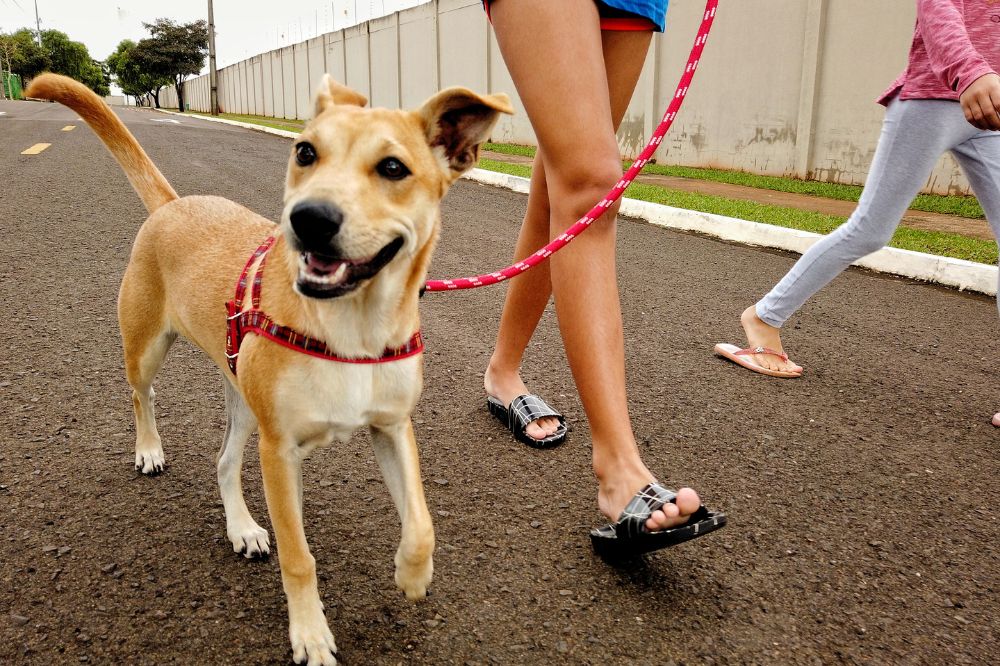There’s something magical about a dog’s anticipation as they hear the jingle of their leash, the sheer excitement in their eyes, and the boundless joy they bring to every walk. Beyond the tail-wagging happiness, regular dog walks are essential to your furry friend’s well-being. In this blog, we’ll dive into the world of dog walks, exploring how often you should take your pup out, the ideal duration, the health benefits, and some common mistakes to avoid. Let’s embark on this journey towards healthier, happier dogs!

The Health Benefits of Regular Dog Walks
First things first, why are dog walks so crucial for your four-legged friend? Walking your dog is a vital cornerstone of responsible pet ownership, as it goes beyond mere exercise. It’s a daily ritual that nurtures the physical, mental, and emotional well-being of your furry friend. Those moments on the leash offer more than just a chance for your dog to stretch their legs; they’re opportunities to explore, engage with the world, and satisfy their innate curiosity. Regular walks also contribute to maintaining a healthy weight, which is crucial for preventing obesity-related health issues. Moreover, the bonding experience between you and your dog during these outings strengthens your relationship, deepening the trust and affection you share. In essence, walking your dog isn’t just a chore – it’s a priceless gift of health, happiness, and companionship that both you and your beloved pet cherish.
- Physical Fitness: Just like us, dogs need regular exercise to stay in shape. Walks help maintain a healthy weight, preventing obesity and related health issues.
- Mental Stimulation: Exploring new scents, sights, and sounds during walks is like a mental workout for your dog. It keeps their brains sharp and engaged.
- Bonding Time: Walks are an opportunity for quality bonding between you and your pup. The shared experience strengthens your connection.
- Socialization: Encounters with other dogs and people during walks help your dog become well-adjusted and friendly.
- Behavioral Improvement: Regular walks can reduce behavioral problems like excessive barking, chewing, or digging. It’s an excellent outlet for their energy.
Walking for Different Ages and Breeds
When it comes to dog walking, one size does not fit all – it’s all about tailoring your approach to your dog’s breed and size. Smaller breeds may seem tiny, but they often pack a lot of energy, so they benefit from frequent, shorter walks. Medium-sized dogs generally thrive on a daily routine that provides them with a healthy balance of exercise and mental stimulation. Large breeds have more stamina but can be prone to joint issues, so giving them moderate and regular exercise is essential. Additionally, working and herding breeds are intelligent and active, so that they may require physical and mental challenges during walks. By recognizing and accommodating these breed-specific needs, you can help ensure your dog gets the right amount of exercise and mental enrichment, promoting their overall well-being.
- Walking Puppies: Puppies have tons of energy but need shorter, more frequent walks. About 15-20 minutes, several times a day is ideal.
- Walking Adult Dogs: Most adult dogs thrive with a daily 30-minute to 1-hour walk, depending on breed and energy level.
- Walking Senior Dogs: Older dogs still benefit from walks, but their pace might be slower. Two shorter walks are better than one long one.
- Walking Small Breeds: Smaller dogs often have higher energy levels relative to their size. They may need more frequent walks.
- Walking Large Breeds: Bigger dogs typically have more stamina but can be prone to joint issues. Regular, moderate exercise is crucial.

How Often and How Long Should You Walk Your Dog
The frequency of dog walks typically depends on your dog’s age, breed, and energy level. Generally, most dogs benefit from a daily walk, providing them with mental stimulation and the physical exercise necessary to stay happy and healthy. Keep in mind that consistency is critical, and sticking to a regular walking schedule helps establish a routine and keeps your furry friend engaged and content. Ultimately, understanding your dog’s unique needs and observing their cues will guide you in determining the perfect walking frequency for them. Finding the right balance between frequency and duration is vital.
- Frequency: Most dogs benefit from a daily walk. If your schedule allows, twice a day is even better.
- Duration: Aim for at least 30 minutes to an hour per walk, depending on your dog’s age and breed.
- Pay Attention to Signs: Watch for signs of fatigue or overexertion. If your dog starts lagging behind or panting excessively, it’s time to take a break.
Walking in Different Weather Conditions
Dog walking in different seasons can be an exciting and ever-changing experience for you and your furry companion. Each season offers its unique charm, and adapting your walks to the weather ensures you and your dog can enjoy the outdoors all year round. Rain or shine, your dog’s health doesn’t take a day off. Here are some tips for walking in various weather conditions:
- Hot Weather: Walk early or late in the day when it’s cooler. Bring water, and be mindful of hot pavement that can burn paws.
- Cold Weather: Invest in a cozy doggy sweater, and be cautious of ice. Shorten walks on extremely cold days.
- Rainy Days: Embrace the wetness with a waterproof leash and coat. Dogs often enjoy the novelty of puddles!

Creating a Regular Dog Walking Schedule
Establishing a walking routine for you and your dog is not just about exercise; it’s about creating a bond and ensuring your pup’s well-being. Consistency is key; try to stick to the same time each day for walks. Dogs thrive on a routine because it helps them know what to expect. Flexibility is also essential; adapt the schedule to your dog’s needs. Some days, they require longer walks, while shorter ones will suffice on others. Combining exercise with mental stimulation, like playing fetch or incorporating puzzle toys, can enrich walks. By establishing a routine that suits you and your furry friend, you create a dependable and enjoyable ritual that strengthens your bond and contributes to your dog’s happy, healthy life.
Common Dog Walking Mistakes
Some common mistakes pet owners make with dog walking can hinder your walks’ enjoyment and safety. One prevalent mistake is skipping walks or not maintaining a consistent schedule, which can lead to pent-up energy and behavioral problems. Overexertion is another issue; pushing your dog too hard or for too long can result in fatigue, joint strain, or injuries. Ignoring safety precautions, such as using a leash in public places or ensuring your dog’s ID tags are up to date, can put your dog and others at risk. Lack of variety in your walking routine can also lead to boredom and missed opportunities for mental stimulation. Avoiding these mistakes ensures that every walk is a positive and enriching experience for you and your furry companion.

Finding the Right Balance in Regular Dog Walks
Ultimately, the key to successful regular dog walks is finding the right balance between your dog’s needs and your lifestyle. Whether it’s a leisurely stroll through the park or an adventurous hike through the woods, remember that every step you take together strengthens the bond you share. Regular dog walks aren’t just about exercise; they’re about creating a happy, healthy, and well-rounded life for your furry companion. By understanding your dog’s unique needs, staying mindful of their health, and embracing the joy of every walk, you’re not only improving their quality of life but also deepening the special connection you share. So, leash up, step outside, and let the adventure begin – because every walk is a journey of love, discovery, and boundless happiness! Are you looking for a dog walker near you? Contact Latchkey Pets today!
